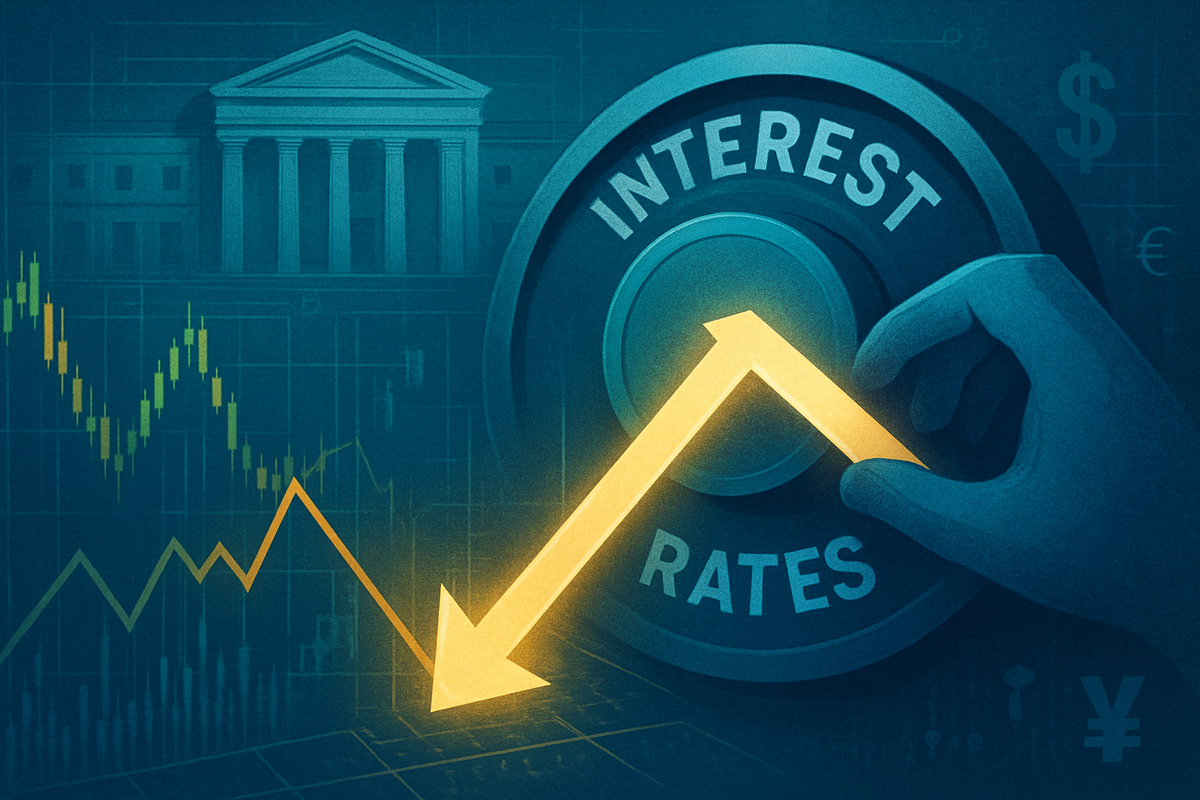
As October 28, 2025 draws to a close, financial markets are holding their breath in anticipation of the Federal Reserve's critical two-day policy meeting, set to conclude tomorrow. A consensus has firmly established itself among investors and analysts: another interest rate cut is not just expected, but largely priced in. This pivotal moment comes as the U.S. economy navigates a delicate balance of a softening labor market and slowly moderating inflation, setting the stage for significant shifts in monetary policy and potentially reshaping the investment landscape for the remainder of the year and beyond.
The imminent decision from the Federal Open Market Committee (FOMC) is widely believed to involve a 25-basis-point reduction in the federal funds rate, a move that would mark the second consecutive cut in 2025. This proactive easing is seen as a strategic "risk management cut," aimed at bolstering economic growth and supporting employment amidst emerging headwinds. While the immediate reaction is expected to be a boost for equity markets, particularly growth-oriented sectors, the Fed's forward guidance will be meticulously scrutinized for clues about the trajectory of future policy, with implications that could ripple through every corner of the financial world.
The Fed's Delicate Dance: Navigating a Softening Economy
The current market expectations for a rate cut are deeply rooted in recent economic data, painting a picture of an economy that requires careful calibration from the central bank. A significant driver behind the anticipated easing is a discernible weakening in the U.S. labor market. Recent reports indicate a slowdown in job growth and an uptick in unemployment claims, signaling that the tight labor conditions experienced over the past few years may be easing. This moderation provides the Federal Reserve with increased impetus to adopt a more accommodative stance, aligning with its mandate to achieve maximum employment.
Concurrently, signs of moderating inflation have provided the Fed with additional room to maneuver. The September Consumer Price Index (CPI) registered an annual rate of 3%, a figure that, while still above the Fed's long-term target of 2%, came in cooler than market expectations. This gradual deceleration in price increases offers a crucial window for the central bank to support economic activity without immediately stoking fears of runaway inflation. The delicate balance between managing employment and price stability remains at the forefront of the Fed's decision-making process.
For the upcoming October 29th FOMC meeting, market participants are almost entirely pricing in a 25-basis-point reduction, which would lower the federal funds rate target range from its current 4.00%-4.25% to 3.75%-4.00%. This follows a similar reduction in September, marking the first rate cut since December 2024. Beyond the immediate decision, there is also considerable discussion surrounding the Federal Reserve potentially winding down its quantitative tightening (QT) program. An end to QT, possibly by December, would inject more liquidity into the financial system, further loosening monetary conditions and signaling a more dovish overall policy direction.
The forward guidance from Fed Chair Jerome Powell and the official FOMC statement will be paramount. The September rate cut was characterized as a "risk management cut," a proactive measure to mitigate potential economic slowdowns. Investors will be dissecting every word for signals regarding the future trajectory of monetary policy. The Fed is expected to reiterate its data-dependent approach, emphasizing that policy decisions are not on a "pre-set course" and will be made "meeting by meeting." This stance underscores the central bank's commitment to flexibility, balancing its dual mandate amidst evolving economic indicators, while also cautioning against overly aggressive market expectations for continuous easing.
Winners and Losers: Corporate Fortunes in a Looser Monetary Environment
A shift towards lower interest rates, as anticipated from the Federal Reserve, typically creates a clear divide between companies poised to benefit and those that may face increased headwinds. The immediate beneficiaries are often growth stocks and technology companies. These firms, frequently characterized by high valuations based on future earnings potential, see their prospects enhanced as lower discount rates increase the present value of those distant cash flows. Companies like Apple (NASDAQ: AAPL), Microsoft (NASDAQ: MSFT), and Amazon (NASDAQ: AMZN), with their robust growth trajectories and often significant capital expenditure needs, could experience a boost as borrowing costs decrease and investor appetite for growth intensifies.
Conversely, businesses with substantial debt loads or those operating on thin margins might find some relief from reduced interest expenses, but the underlying economic conditions prompting the cuts (like a weakening labor market) could still pose challenges. Highly speculative ventures, particularly those that rely heavily on cheap capital, may still face scrutiny. While lower rates generally improve access to capital, the "new era of financial discipline" means that investors are increasingly favoring companies with strong fundamentals and sustainable cash flows over highly leveraged or unproven business models. Therefore, while the cost of borrowing may decrease, the bar for demonstrating profitability and financial health remains high.
Sectors like real estate and housing could also see a positive impact. Lower mortgage rates tend to stimulate demand from homebuyers, benefiting homebuilders such as D.R. Horton (NYSE: DHI) and real estate investment trusts (REITs) like Prologis (NYSE: PLG) focused on residential or commercial properties. Consumer discretionary companies, which thrive when consumers have more disposable income and access to credit, could also experience a lift. Conversely, financial institutions, particularly banks like JPMorgan Chase (NYSE: JPM) and Bank of America (NYSE: BAC), might face pressure on their net interest margins if the spread between what they earn on loans and what they pay on deposits narrows too much, although increased lending activity could partially offset this.
Furthermore, companies involved in renewable energy and infrastructure development could benefit from lower long-term financing costs, making large-scale projects more economically viable. On the other hand, sectors sensitive to economic slowdowns, even if rates are falling, might still struggle if the rate cuts are primarily a response to weakening demand. Investors will need to carefully assess individual company fundamentals and their sensitivity to both interest rate changes and broader economic trends to identify true winners and losers in this evolving landscape.
Wider Significance: A New Chapter for Monetary Policy
The Federal Reserve's anticipated rate cut, and the broader shift in its monetary policy, signifies a pivotal moment that extends beyond immediate market reactions, embedding itself into wider industry trends and potentially reshaping the economic narrative for years to come. This move fits squarely into a broader trend of central banks globally grappling with persistent, albeit moderating, inflation while trying to avoid a significant economic downturn. The "risk management cut" philosophy highlights a proactive approach, rather than a reactive one, indicating a lesson learned from past economic cycles where delayed action exacerbated downturns.
The ripple effects of this policy shift are likely to be far-reaching. Competitors and partners across various industries will need to adapt to a new interest rate environment. For instance, companies that have relied on higher interest rates to generate income from cash reserves might see their strategies challenged, while those with significant investment plans might find capital cheaper. Regulatory bodies will also be watching closely, as prolonged periods of low interest rates can sometimes lead to asset bubbles or increased systemic risk, potentially prompting new oversight or policy considerations to maintain financial stability.
Historically, periods of Fed easing have often preceded or coincided with economic recoveries, offering a precedent for optimism. However, the current environment is unique, characterized by the lingering effects of supply chain disruptions, geopolitical tensions, and a labor market that, while softening, remains relatively robust compared to pre-pandemic levels. Comparisons to previous easing cycles, such as those following the 2008 financial crisis or the dot-com bust, must be made with caution, as the underlying economic structures and global interconnectedness have evolved significantly. This cycle appears to be more about fine-tuning the economy to achieve a "soft landing" rather than recovering from a deep recession.
Moreover, the potential winding down of quantitative tightening (QT) would mark another significant policy pivot. While rate cuts address the price of money, ending QT would address the quantity of money in the financial system. This dual approach signals a comprehensive strategy to inject liquidity and stimulate growth. The implications for bond markets, corporate debt, and even international capital flows are substantial, as the U.S. dollar's strength and global investment patterns are intricately linked to the Fed's balance sheet operations. This new chapter in monetary policy emphasizes adaptability and a willingness to adjust course in response to dynamic economic conditions.
What Comes Next: Navigating the Path Ahead
Looking ahead, the Federal Reserve's actions in late 2025 and early 2026 will be critical in shaping the economic trajectory. In the short term, market participants are already anticipating an additional rate cut in December, suggesting a continued easing cycle. Beyond that, some projections extend this easing, forecasting potentially two more cuts in 2025 and another in 2026, depending on how economic data evolves. This prolonged period of monetary easing, if it materializes, could further stimulate economic activity, but also carries the inherent risk of rekindling inflationary pressures or contributing to the formation of asset bubbles in the longer term, possibly by late 2026.
Companies will need to strategically pivot and adapt to this evolving interest rate landscape. Businesses that have been conservative with their capital expenditures due to higher borrowing costs might find new opportunities for expansion and investment. Conversely, those that thrived in a higher-rate environment, perhaps by holding significant cash or offering high-yield products, may need to re-evaluate their business models. Market opportunities may emerge in sectors that are highly sensitive to interest rates, such as housing, automotive, and capital-intensive industries. Investors might also seek out dividend-paying stocks as an alternative to lower-yielding bonds, or reallocate capital towards growth sectors.
However, challenges will also persist. The Fed's commitment to a "data-dependent" approach means that any resurgence in inflation or unexpected strengthening of the labor market could prompt a pause or even a reversal in the easing cycle, introducing volatility. Geopolitical events and global economic slowdowns will also continue to exert influence, potentially dampening the impact of domestic monetary policy. The emphasis on "financial discipline" means that while capital might become cheaper, access to it will still favor companies with robust balance sheets and clear pathways to profitability, rather than highly speculative ventures.
Potential scenarios and outcomes range from a successful "soft landing" where inflation is tamed and a recession is avoided, to a more challenging environment where inflation proves stickier than anticipated, or economic growth remains sluggish despite easing. Investors should prepare for continued market dynamism, with a focus on companies that demonstrate resilience, adaptability, and strong underlying fundamentals, regardless of the prevailing interest rate environment.
Wrap-Up: A Market at a Crossroads
The Federal Reserve's anticipated interest rate cut marks a significant inflection point for the financial markets, signaling a proactive shift in monetary policy designed to navigate a softening labor market and moderating inflation. Key takeaways from this event include the Fed's commitment to a "risk management" approach, aiming to pre-empt a deeper economic slowdown, and the widespread expectation of further easing in the coming months. This move is poised to inject liquidity into the system and reduce borrowing costs, providing a tailwind for certain sectors while posing challenges for others.
Moving forward, the market will remain highly sensitive to economic indicators, particularly inflation data and labor market reports. Investors should closely monitor the Fed's forward guidance, scrutinizing statements from Chair Powell for any deviations from the anticipated easing path. The "new era of financial discipline" means that while a lower rate environment might encourage investment, the emphasis will remain on companies with strong fundamentals, sustainable cash flows, and prudent management. Speculative investments, while potentially benefiting from cheaper capital, will likely continue to face heightened scrutiny.
The lasting impact of this policy pivot could be a more stable, albeit slower-growing, economy, or it could set the stage for renewed inflationary pressures or asset bubbles further down the line. What is clear is that investors should watch for opportunities in growth-oriented sectors, evaluate companies based on their ability to thrive in a more competitive capital environment, and remain vigilant against potential market volatility driven by economic surprises or shifts in central bank rhetoric. The coming months will undoubtedly test the market's resilience and adaptability.
This content is intended for informational purposes only and is not financial advice





